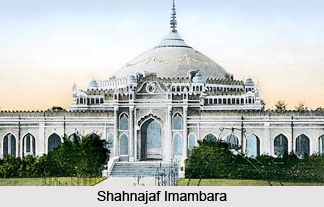 Shah Najaf Imambara is one of the renowned monuments of the Indian city of Lucknow located in the Indian state of Uttar Pradesh. Lucknow, a place popular for delectable seekh kebabs, chikan clothing and also for its vibrant streets lined with shops and street vendors, has many monuments. Among many monuments, Shah Najaf Imambara is a popular structure. The Indian city of Lucknow actually occupies a crucial place for the Muslims of Lucknow and also for the entire country. The monument depicts a beautiful piece of architecture and is situated at a convenient distance from the various points of transit. Shah Najaf is the title which was given to Maula Ali, the supposed son in law of Prophet Muhammad, who made his sincerest efforts to protect the emerging religion of Islam.
Shah Najaf Imambara is one of the renowned monuments of the Indian city of Lucknow located in the Indian state of Uttar Pradesh. Lucknow, a place popular for delectable seekh kebabs, chikan clothing and also for its vibrant streets lined with shops and street vendors, has many monuments. Among many monuments, Shah Najaf Imambara is a popular structure. The Indian city of Lucknow actually occupies a crucial place for the Muslims of Lucknow and also for the entire country. The monument depicts a beautiful piece of architecture and is situated at a convenient distance from the various points of transit. Shah Najaf is the title which was given to Maula Ali, the supposed son in law of Prophet Muhammad, who made his sincerest efforts to protect the emerging religion of Islam.
One can reach the place easily by hiring a cab or an auto which will available from the hotel. Non-Muslims are not allowed inside this Imambara. One can visit this tourist attraction at anytime of the year.
History of Shah Najaf Imambara
History of Shah Najaf Imambara in the city of Lucknow takes a tourist back to the ancient times when Islam was in the nascent state and still struggling to make its own mark. Moula Ali or Shah Najaf, the son-in-law of Prophet Muhammad, was a great intellectual as well as a brave warrior. His valiant endeavours in protecting and popularizing Islam won him the title of Haider-e-Khuda, meaning "Lion of Allah". He later became the 4th Caliph of Islam. The Imambara is dedicated to him.
Description of Shah Najaf Imambara
Shah Najaf Imambara, situated near Chariton Hotel, Shah Najaf Imambara in Lucknow is one of the best and the most splendid monuments in Lucknow. This Imambara, in particular, is in shape of dome on the bank of Gomti River on the right side. This structure was built in the city of Lucknow by Nawab Ghazi-ud-Din Haider to serve as his mausoleum.
This mausoleum is also the storeroom of the remains of Ghazi-ud-din Haider and his wives that also include Mubarak Mahal, his European wife. The entrance of the mausoleum will take you to a scenic garden that is beautifully adorned with the various types of flowers.
At the centre of the building there lies the silver tomb of Ghazi-ud-din Haider and is located in between the more impressive silver and gold tomb of Mubarak Mahal and another tomb. The tombs and their design patterns are simply a delight to watch and hence add to the experience of a good travel for the tourists.



















